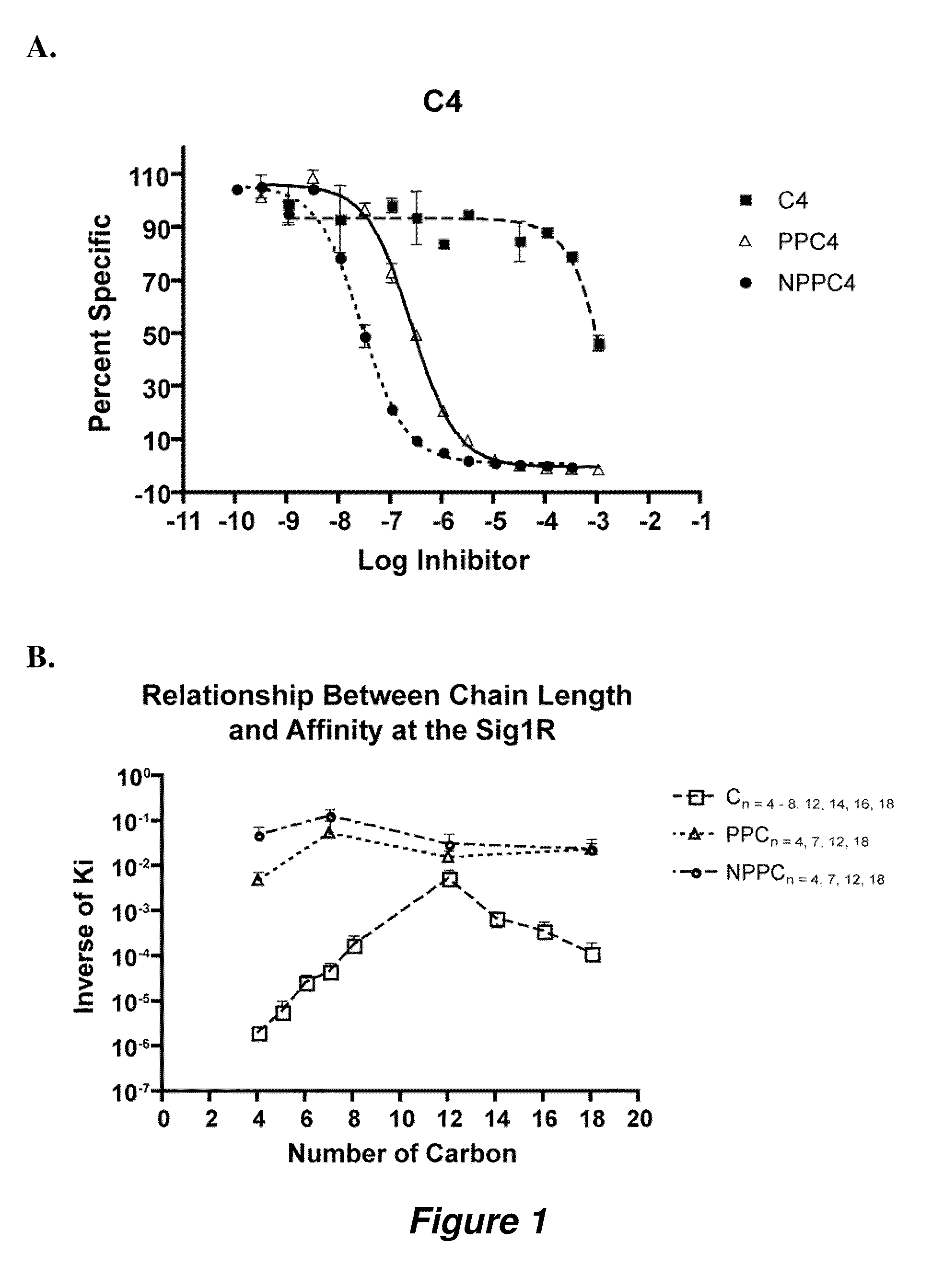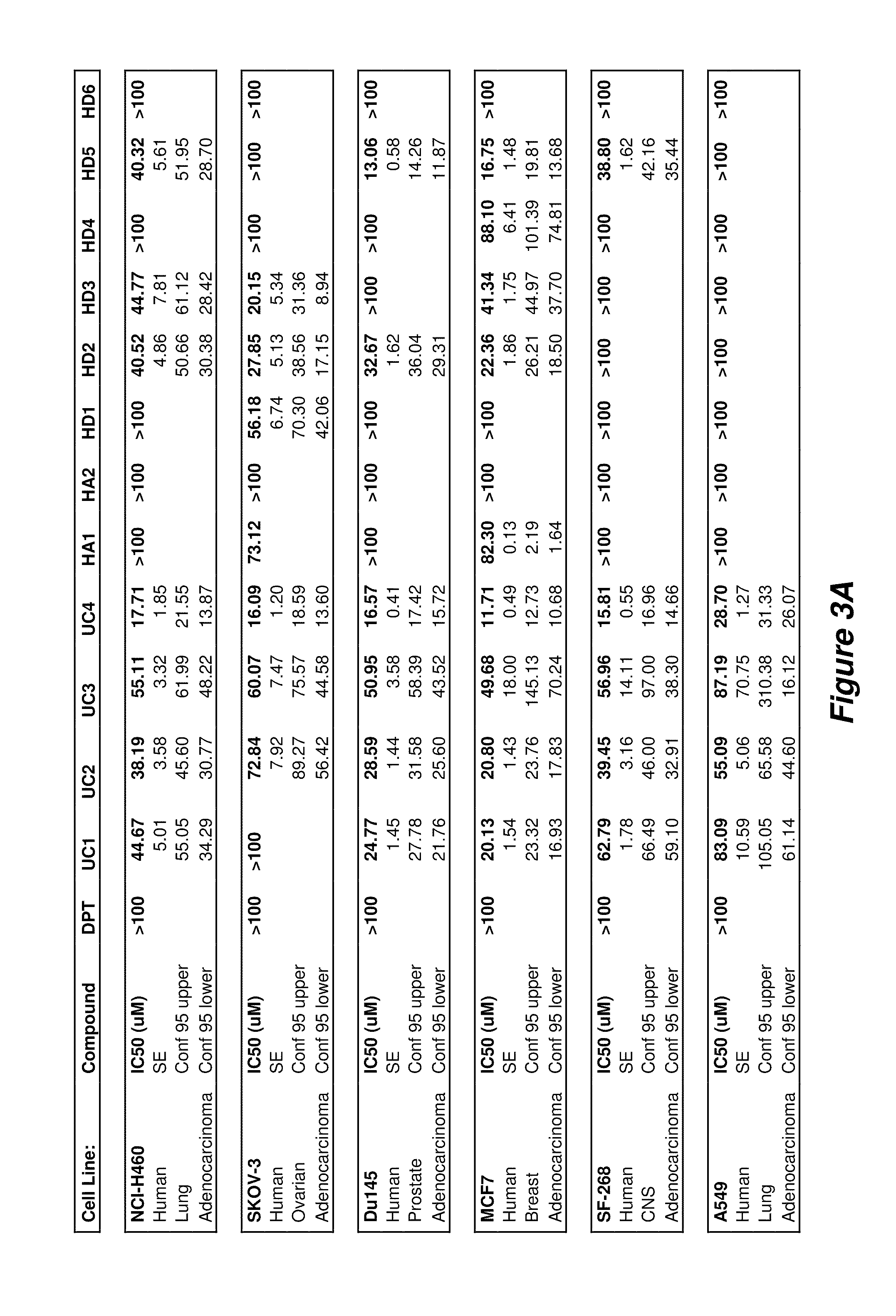Sigma-1 receptor ligands and methods of use
a technology of sigma-1 receptor and ligand, which is applied in the field of sigma-1 receptor ligand and methods of use, can solve the problems of scarce ligands, particularly antagonists of sigma-1 receptor, and poorly studied
- Summary
- Abstract
- Description
- Claims
- Application Information
AI Technical Summary
Benefits of technology
Problems solved by technology
Method used
Image
Examples
example 1
Preparation of N-Alkylamine Compounds
Synthesis of 1-bromo-3-(4-nitrophenyl)propane
[0092]
[0093]The preparation of 1-bromo-3-(4-nitrophenyl)propane from 1-bromo-3-phenylpropane (Aldrich) was carried out according to the methods of Hajipour et al. (Tetrahedron Lett., 2005. 46: 8301-8310). Briefly, P2O5 and silica gel was ground at room temperature for 1 minute to homogeneity. A P2O5 / silica gel mixture (1 mmol) and 1-bromo-3-phenyl-propane (1 mmol, 0.199 g) were combined and ground for 30 seconds before 0.5 mL of 65% HNO3 was added. Additional grinding was carried out until TLC analysis (n-Hexane / EtOAc 9:1) showed a complete disappearance of 1-bromo-3-phenylpropane (˜6 minutes). The product was extracted from the silica gel with ethyl acetate (10 mL), and was washed (H2O) and dried (MgSO4). Solvent was evaporated under reduced pressure and the product was purified by column chromatography (n-Hexane / EtOAc, 9:1). 1-Bromo-3-(4-nitrophenyl)propane was obtained (0.74 mmol, 0.18 g, 74%) as a ...
example 2
Long Chain N-Alkylamines Bind to the Sigma-1-Receptor
[0104]A. Overexpression and Purification of the Sigma-1 Receptor from E. coli.
[0105]A guinea pig sigma-1 receptor was purified as previously described (Ramachandran et al., Protein Expr. Purif, 2007. 51(2): 283-92). The pMal P2X plasmid (New England Biolabs) encoding the guinea pig sigma-1 receptor on the C-terminus of the E. coli Maltose Binding Protein was used for purification. The sigma-1 receptor on its C-terminus carried a hexa-histadine epitope tag. Protein was expressed in the E. coli strain BL21 DE3 (Novagen) with 0.6 mM IPTG. The E. coli pellet was sonicated and centrifuged at 100,000 g for 1 hour to separate the particulate and soluble fractions. The particulate fraction was extracted with Triton X-100, centrifuged and the extract was loaded onto an amylose resin (New England Biolabs, E-802). After washing the resin with buffer containing 0.5% Triton X-100, the MBP-sigma-1 receptor fusion protein was eluted with buffer...
example 3
Alkylamine Derivatives as Sigma-1 Modulators
[0121]Table 3 illustrates compounds according to various embodiments of the invention, and their affinity for the sigma-1 receptor. In some embodiments, the compounds can be sigma-1 agonists, and in other embodiments, the compounds can be sigma-1 antagonists.
TABLE 3LigandStructureSigma-1 KD (nM)HD117.7HD20.36HD32590HD46HD57239HD6164HD791UC112UC25.7UC392UC40.39DMT14600DPT1600
[0122]These compounds show inhibitory properties and high selectivity against several cancer cell lines, as illustrated in FIGS. 3 and 4. For example, nitrophenylpropyl-N-hepylamine (UC2) and nitrophenylpropyl-N-dodecylamine (UC4) show remarkable activity for inhibiting tumor growth. Therefore, a number of high affinity sigma-1 receptor ligands have been developed that are shown to be cytotoxic and / or selective against a number of cancer cells lines including breast, lung, prostate, ovarian, colorectal, and CNS adenocarcinoma cells, for example, the cell lines recited i...
PUM
| Property | Measurement | Unit |
|---|---|---|
| Molar density | aaaaa | aaaaa |
| Molar density | aaaaa | aaaaa |
| Molar density | aaaaa | aaaaa |
Abstract
Description
Claims
Application Information
 Login to View More
Login to View More - R&D
- Intellectual Property
- Life Sciences
- Materials
- Tech Scout
- Unparalleled Data Quality
- Higher Quality Content
- 60% Fewer Hallucinations
Browse by: Latest US Patents, China's latest patents, Technical Efficacy Thesaurus, Application Domain, Technology Topic, Popular Technical Reports.
© 2025 PatSnap. All rights reserved.Legal|Privacy policy|Modern Slavery Act Transparency Statement|Sitemap|About US| Contact US: help@patsnap.com



